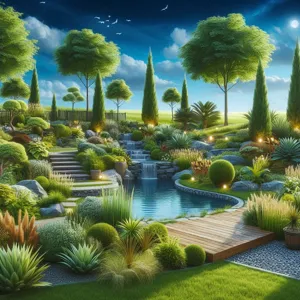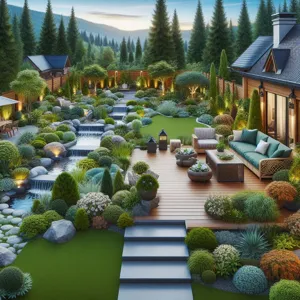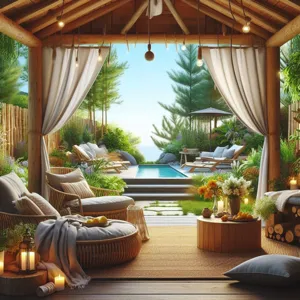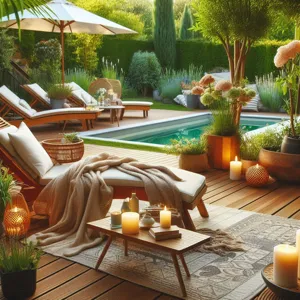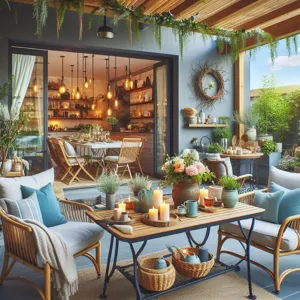Imagine stepping outside into your own personal oasis, where the gentle rustle of leaves and the warm glow of sunlight create an inviting atmosphere for relaxation and entertainment.
A well-designed patio can transform any outdoor space into a paradise, and the right patio cover is essential for creating a comfortable environment that allows you to enjoy the outdoors, rain or shine. In this comprehensive guide, we will explore the diverse array of patio cover options available, from elegant pergolas that invite the dappled sunlight to modern retractable awnings that provide versatility and shade at a moment’s notice. Whether you’re dreaming of a cozy nook for morning coffee or an expansive area for lively gatherings, we’ll delve into the materials, styles, and features of various patio covers, helping you choose the perfect solution to enhance your outdoor living experience. Get ready to transform your patio into a stylish retreat where every moment spent outside feels like a mini-vacation!
1. Introduction to Patio Covers: Enhancing Your Outdoor Space

When it comes to transforming your outdoor space into a true oasis, patio covers play a pivotal role. These versatile structures not only provide shade and protection from the elements but also enhance the aesthetic appeal of your backyard or patio area. Imagine lounging on a sunny afternoon, sipping your favorite drink, while being shielded from harsh UV rays – that’s the magic of a well-designed patio cover.
Patio covers come in a variety of styles, materials, and designs, each offering unique benefits and charm. Whether you prefer the rustic allure of wood, the modern sleekness of aluminum, or the timeless elegance of a fabric canopy, there’s a patio cover to suit every taste and architectural style. Beyond mere functionality, these covers can serve as an extension of your indoor living space, creating a seamless transition between your home and nature.
In this guide, we’ll explore the different types of patio covers available, helping you make an informed decision about which one best fits your lifestyle and enhances your outdoor paradise. From permanent structures that provide year-round utility to retractable options that allow you to enjoy the sun when you want it, we will delve into the features and advantages of each type. So, let’s embark on this journey to discover how patio covers can elevate your outdoor experience, making your patio an inviting haven for relaxation, entertainment, and cherished moments with family and friends.
2. Benefits of Using Patio Covers
Patio covers are more than just a stylish addition to your outdoor space; they offer a plethora of benefits that can enhance your patio experience and extend the usability of your outdoor area. One of the primary advantages of installing a patio cover is the protection it provides against the elements. Whether it’s shielding you from the harsh rays of the sun during a blistering summer day or keeping you dry during unexpected rain showers, a patio cover creates a comfortable environment that allows you to enjoy your outdoor space regardless of the weather.
Additionally, patio covers help to preserve your furniture and decor. By providing shade and protection from rain, snow, and debris, they can significantly extend the life of your patio furniture, cushions, and other decorative elements. This means less money spent on replacements and more time enjoying your beautifully designed outdoor oasis.
Another key benefit is the increase in property value. A well-constructed patio cover can enhance the aesthetic appeal of your home, making it more attractive to potential buyers. It signals that your outdoor space is functional and well-maintained, which can be a significant selling point in the real estate market.
Furthermore, patio covers can also offer a sense of privacy and intimacy. They create a cozy nook where you can unwind, entertain, or enjoy a meal with family and friends without feeling exposed to the surrounding neighborhood. This added sense of seclusion can transform your patio into a true retreat, encouraging you to spend more time outdoors.
Finally, many patio covers can be customized to fit your style and needs, whether you prefer a traditional wooden structure, a sleek metal design, or a fabric canopy that can be retracted when not in use. Each option not only provides the practical benefits mentioned above but also allows you to express your personal aesthetic and enhance the overall look of your home. As you explore the various types of patio covers available, consider these benefits to find the perfect addition to your outdoor paradise.
3. Types of Patio Covers Overview

When it comes to enhancing your outdoor space, patio covers play a crucial role in defining the ambiance and functionality of your patio area. With an array of options available, selecting the right type of patio cover can transform your outdoor experience, offering both protection and aesthetic appeal. Here’s an overview of the most popular types of patio covers, each with its unique features and benefits:
1. **Pergolas**: These stylish structures are characterized by their open-roof design, making them perfect for allowing sunlight to filter through while providing partial shade. Typically made from wood or vinyl, pergolas can serve as a beautiful focal point adorned with climbing plants or draped fabrics, creating an enchanting atmosphere for gatherings or quiet evenings.
2. **Awnings**: Awnings are versatile and practical, offering a retractable solution for those who want to adjust their shade levels throughout the day. Available in various materials, including fabric and aluminum, awnings can be mounted directly to your home or a freestanding structure. Their ability to block harmful UV rays while allowing a cool breeze to flow makes them a popular choice.
3. **Patio Umbrellas**: For a more casual and portable option, patio umbrellas provide instant shade and can be easily moved to accommodate changing sunlight angles. They come in various sizes, colors, and styles, making them an ideal choice for smaller patios or dining setups. Look for options with UV protection to ensure longevity and safety.
4. **Solid Roof Covers**: If you’re seeking maximum protection from the elements, solid roof covers are an excellent choice. Made from materials such as aluminum, wood, or polycarbonate, these covers offer complete shelter from rain, snow, and intense sunlight, allowing you to enjoy your patio year-round. They can even be designed to match your home’s architecture, seamlessly blending indoor and outdoor spaces.
5. **Lattice Covers**: Lattice covers provide a charming, semi-shaded environment perfect for growing vines and flowering plants. This type of cover allows light to filter through while still offering some degree of protection from the sun. Lattice can be a lovely addition to any garden-themed patio, creating a cozy, inviting atmosphere.
6. **Screened Enclosures**: For those looking to enjoy the outdoors without the hassle of insects, screened enclosures are a fantastic option. These structures safeguard your patio from pesky bugs while allowing fresh air and natural light to pour in. They can be customized with various screen materials, making them suitable for different climates and environments.
With such a diverse range of patio cover options available, you can choose the one that best fits your lifestyle, aesthetic preferences, and budget. Whether you’re looking to create a serene relaxation spot, an entertaining space, or a lush garden retreat, the right patio cover can elevate your outdoor experience to new heights.
4. Pergolas: A Blend of Style and Functionality
When it comes to enhancing your outdoor space, pergolas stand out as a stunning fusion of style and functionality. These elegant structures, often characterized by their open-slat roofs and vertical posts, offer a unique way to define an outdoor area while allowing for an abundance of natural light and fresh air. Perfect for creating a cozy nook for relaxation or an inviting space for entertaining, pergolas serve as both a stylish visual centerpiece and a practical addition to your patio.
Crafted from a variety of materials, including wood, metal, and vinyl, pergolas can be customized to match your home’s architecture and your personal aesthetic. A wooden pergola, for instance, brings a warm and rustic charm, while a sleek metal design can impart a modern vibe. You can also enhance the beauty of your pergola with climbing plants, such as wisteria or grapevines, which effortlessly intertwine with the structure, adding a lush, green canopy that provides gentle shade during sunny days.
Functionality is another key advantage of pergolas. While they offer partial shelter from the sun, they are not fully enclosed, allowing for a refreshing breeze to flow through. This makes them an ideal choice for warm climates, where you want to enjoy the outdoors without being completely exposed. Many homeowners choose to complement their pergolas with additional features like outdoor curtains, retractable canopies, or built-in lighting, creating an adaptable space that can transition seamlessly from day to night.
Incorporating a pergola into your patio design not only enhances the visual appeal of your outdoor area but also elevates the overall experience. Whether you envision hosting lively gatherings with friends or enjoying quiet moments with a good book, a pergola can transform your patio into a personal paradise that invites you to unwind and savor the beauty of the outdoors.
5. Awnings: Versatile Protection from the Elements
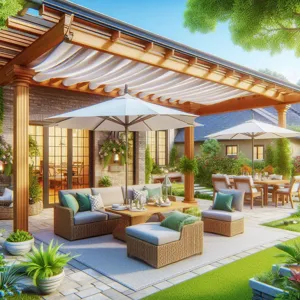
Awnings are a fantastic option for those seeking versatile protection from the elements while enhancing the aesthetic appeal of their outdoor spaces. These fabric coverings, often attached to the exterior of a building, provide shade and shelter without the need for a permanent structure. Available in a variety of materials and styles, awnings can be custom-fitted to suit any patio dimension, making them a flexible choice for homeowners looking to create a comfortable outdoor oasis.
One of the key advantages of awnings is their ability to provide immediate relief from the sun’s harsh rays. By blocking direct sunlight, they help maintain a cooler patio environment, allowing you and your guests to enjoy al fresco dining or lounging even during the hottest days of summer. Additionally, awnings can protect your outdoor furniture from fading and wear caused by prolonged sun exposure, extending its lifespan and keeping your patio looking fresh and inviting.
Awnings come in two main types: stationary and retractable. Stationary awnings are fixed in place and offer consistent coverage, making them ideal for areas that need shade year-round. On the other hand, retractable awnings provide the flexibility to control how much sun or shade you want at any given time. With the simple push of a button or a manual crank, these awnings can be extended or retracted, allowing you to adapt to changing weather conditions or personal preferences.
Moreover, awnings can significantly enhance your home’s curb appeal. With a myriad of colors, patterns, and designs available, you can choose an awning that complements your home’s exterior and reflects your personal style. Whether you’re aiming for a classic, elegant look or a more modern vibe, there’s an awning design to match.
In addition to their protective qualities, awnings can also contribute to energy efficiency. By reducing the amount of heat that enters your home through windows, they can help lower cooling costs during warm months, making them an environmentally friendly choice as well.
In summary, awnings offer a versatile solution for those looking to shield their patios from the elements while also adding a touch of style to their outdoor space. With their ease of use, aesthetic appeal, and practical benefits, awnings are a worthy consideration for anyone looking to enhance their patio experience.
6. Louvered Roofs: Adjustable Shade and Sunlight
Louvered roofs represent the pinnacle of versatility when it comes to patio covers, allowing homeowners to seamlessly blend the beauty of the outdoors with the comfort of controlled shade. Featuring adjustable slats that can be opened or closed at various angles, these innovative structures provide the unique ability to customize the amount of sunlight filtering into your outdoor space. Imagine hosting a summer barbecue, where you can tilt the louvers just right to create a perfect balance of sun and shade, ensuring your guests remain comfortable while enjoying the fresh air.
One of the most appealing aspects of louvered roofs is their adaptability to changing weather conditions. On a bright, sunny day, you can fully open the slats to bask in the warmth of the sun, while on a rainy afternoon, simply close them to create a cozy, dry retreat. This flexibility not only enhances your outdoor experience but also protects your furniture and decor from the elements, prolonging their lifespan.
Moreover, louvered roofs come in a variety of materials, such as aluminum, wood, or vinyl, giving you the freedom to choose a style that complements your home’s architecture. Many modern designs also incorporate integrated lighting and heating options, allowing you to extend your outdoor enjoyment into the evening hours or cooler months.
With their sleek aesthetic and functional benefits, louvered roofs are not just a cover; they’re an investment in the versatility and usability of your outdoor living area, transforming your patio into an inviting paradise where you can entertain, relax, or simply enjoy the beauty of nature year-round. Whether you’re sipping coffee in the morning sunlight or hosting evening gatherings under the stars, louvered roofs provide the perfect solution for any occasion.
7. Solid Roof Covers: Maximum Protection and Insulation

Solid roof covers are the stalwarts of patio protection, providing an unparalleled combination of durability, insulation, and aesthetic appeal. These covers are typically constructed from materials such as aluminum, wood, or composite, designed to withstand the elements while offering a cozy outdoor retreat. Whether you’re looking to shield your patio from the relentless sun, unexpected rain, or even snow, solid roof covers serve as a formidable barrier against nature’s whims.
One of the standout features of solid roof covers is their ability to regulate temperature. Unlike their louvered or fabric counterparts, which may allow heat to seep through or create a greenhouse effect, solid roofs provide effective insulation. This means your patio can remain cooler during scorching summer days and warmer during chilly nights, making it a comfortable space to enjoy year-round. Imagine sipping your morning coffee on a crisp autumn day, sheltered from the brisk winds, or hosting a summer barbecue without the worry of sudden downpours ruining the fun.
In terms of design, solid roof covers can be tailored to match your home’s architecture, enhancing its overall curb appeal. With a variety of finishes and colors available, from sleek modern aluminum to rustic wooden beams, you can create a patio that reflects your personal style while seamlessly blending with your home’s exterior. Many homeowners are also opting for added features, such as skylights or built-in ceiling fans, which can elevate the ambiance and functionality of the space.
Additionally, solid roof covers offer excellent durability, requiring minimal maintenance over the years. Unlike fabric canopies that may fray or fade, these robust structures are built to last, saving you time and money in the long run. With the right design and materials, you can create a patio cover that not only protects but also becomes a standout feature of your outdoor living area.
In conclusion, if you’re seeking maximum protection and insulation for your patio, a solid roof cover is an investment worth considering. It offers a perfect blend of functionality and style, ensuring that your outdoor oasis remains a cherished retreat, no matter the season.
8. Shade Sails: Modern and Stylish Solutions
Shade sails have emerged as a chic and contemporary solution for outdoor shading, transforming patios into inviting oases of comfort. These innovative structures, typically made from durable, UV-resistant fabric, are not only practical but can also add a striking aesthetic to your outdoor space. Available in a variety of colors, shapes, and sizes, shade sails can be easily customized to fit your specific patio dimensions and style preferences.
One of the key advantages of shade sails is their versatility. They can be installed in numerous configurations – from simple triangular shapes that provide targeted shade to larger, overlapping sails that create a dramatic visual effect. This flexibility allows homeowners to get creative with their outdoor design, whether they are aiming for a sleek modern look or a more playful and whimsical atmosphere.
In addition to their visual appeal, shade sails offer excellent protection from the sun’s harsh rays, making them an ideal choice for those warm summer days. They can significantly lower the temperature beneath them, creating a cool, comfortable space for relaxation, dining, or entertaining. Moreover, the breathable fabric allows for air circulation, reducing the risk of stuffiness that can sometimes plague covered patios.
Installation is relatively straightforward, often requiring only a few sturdy posts and tensioning hardware to secure the sails in place. This means that you can easily set them up in your backyard, at a park, or even at outdoor events. Plus, they are often more affordable than traditional permanent structures like pergolas or gazebos, making them a budget-friendly option for homeowners looking to enhance their outdoor living area.
Ultimately, shade sails represent a modern solution to the age-old problem of outdoor sun exposure. With their stylish designs and practical benefits, they can elevate your patio experience, allowing you to enjoy your outdoor space to the fullest while remaining protected from the elements. Whether you’re hosting a summer BBQ or simply relaxing with a book, shade sails provide the perfect blend of form and function that every patio deserves.
9. Screened Enclosures: Combining Comfort and Bug Protection
When it comes to creating the perfect outdoor oasis, screened enclosures offer a unique blend of comfort and practicality that can elevate your patio experience. Imagine lounging on your patio, sipping iced tea, and enjoying the gentle breeze—without the annoyance of pesky insects interrupting your tranquility. Screened enclosures provide a barrier that keeps bugs at bay while allowing fresh air and natural light to flood your space.
These versatile structures can be customized to fit any style, from rustic wooden frames to modern aluminum designs, seamlessly integrating with your home’s architecture. Whether you want a simple screen room that extends your living space or a more elaborate structure with additional features like ceiling fans or skylights, the options are limitless. This adaptability ensures that your screened enclosure can serve multiple purposes—from a cozy reading nook to a lively gathering spot for friends and family.
Additionally, a screened enclosure protects your patio furniture and decor from the elements, reducing wear and tear caused by sun exposure and rain. With the added benefit of enhancing your property’s value, investing in a screened enclosure is not just about immediate comfort; it’s a long-term enhancement for your home.
In essence, screened enclosures create a serene retreat where you can enjoy the beauty of nature while remaining shielded from its less desirable aspects. With this thoughtful addition, your patio can truly become a year-round haven for relaxation and entertainment, allowing you to savor every moment spent outdoors.
10. DIY Patio Covers: Tips for the Creative Homeowner
Creating a DIY patio cover can be an incredibly rewarding project for the creative homeowner, blending personal style with practicality. Not only does it enhance your outdoor space, but it also provides valuable shelter from the elements, allowing you to enjoy your patio year-round. Here are some tips to help you embark on this fulfilling journey.
**1. Assess Your Space:** Start by evaluating the size and shape of your patio. Consider the existing elements such as furniture, plants, and pathways. This will guide your design and ensure that your cover complements the overall aesthetics of your outdoor area.
**2. Choose the Right Materials:** The type of material you select will significantly impact both the look and durability of your patio cover. Popular choices include wood, which offers a classic, warm feel; metal, which provides a modern and sleek appearance; and fabric, which can add a soft touch and versatility. Make sure to choose materials that can withstand local weather conditions to ensure longevity.
**3. Design for Functionality:** Think about how you want to use your patio. Do you want a space that’s completely shaded, or do you prefer a mix of sun and shade? Adjustable louvered roofs, pergolas with climbing plants, or even retractable awnings can provide the flexibility to adapt to changing weather and personal preference.
**4. Gather Proper Tools:** Before you start, ensure you have all the necessary tools, such as a saw, drill, level, and measuring tape. A well-prepared workspace will make the construction process smoother and more efficient.
**5. Follow Safety Guidelines:** Safety should always be a priority. Make sure to follow building codes and regulations in your area, especially if you plan to build a permanent structure. Wearing protective gear and ensuring a sturdy foundation will prevent accidents and ensure that your patio cover stands the test of time.
**6. Personalize Your Space:** This is your opportunity to let your creativity shine! Consider adding unique elements like fairy lights, hanging planters, or built-in seating to enhance your patio cover. These personal touches will make your outdoor space feel like an extension of your home.
By diving into a DIY patio cover project, not only do you gain a functional addition to your home, but you also create a space that reflects your unique style and enhances your outdoor living experience. Whether you’re sipping coffee in the morning sun or hosting a lively evening gathering, a well-crafted patio cover can transform your outdoor area into a true patio paradise.
11. Choosing the Right Material for Your Patio Cover
When it comes to selecting the perfect material for your patio cover, the choices can feel overwhelming. Each material offers its own unique benefits and aesthetic appeal, and the right choice can elevate your outdoor space while ensuring durability and functionality. Here’s a breakdown of some popular options to help you make an informed decision.
**Wood:** Classic and timeless, wooden patio covers provide a natural, warm aesthetic that blends beautifully with outdoor environments. They can be customized in various styles and finishes, giving you the flexibility to match your home’s architecture. However, wood requires regular maintenance to prevent rot and weathering, so be prepared for periodic staining or sealing.
**Aluminum:** For those seeking a low-maintenance option, aluminum patio covers are a fantastic choice. They are lightweight, resistant to rust, and can withstand harsh weather conditions, making them ideal for year-round use. Aluminum also comes in a variety of colors and finishes, allowing you to achieve a modern or classic look without the upkeep associated with wood.
**Vinyl:** If you want the appearance of wood without the maintenance headaches, vinyl is an excellent alternative. It is durable, resistant to fading, and easy to clean. Vinyl patio covers are also less likely to warp or crack, ensuring that your outdoor space maintains its beauty over time. Plus, they come in a variety of styles to fit any aesthetic.
**Fabric:** For a more casual and flexible option, fabric patio covers can create a cozy atmosphere for relaxation and entertainment. Retractable canopies allow you to adjust the amount of shade according to the time of day, providing versatility. However, fabric options may not be as durable as other materials, so it’s important to choose high-quality, weather-resistant fabrics for longevity.
**Steel or Metal:** For a sturdy and industrial look, steel or metal patio covers are unmatched in durability. They offer incredible strength and can be engineered to withstand heavy winds and snow loads, making them ideal for regions with extreme weather. While they may require some maintenance to prevent rust, their long-lasting nature makes them a worthwhile investment.
As you consider materials, also think about your climate, the style of your home, and how you plan to use your patio space. By weighing the pros and cons of each option, you can select a patio cover that not only enhances the beauty of your outdoor area but also meets your practical needs for years to come.
12. Design Considerations for Your Outdoor Space
When it comes to creating the perfect outdoor oasis, design considerations for your patio cover can significantly impact both functionality and aesthetics. The first step is to assess the layout of your outdoor space. Take note of the size and shape of your patio, as well as existing landscaping elements that can enhance or obstruct your design. Consider whether you want a cover that blends seamlessly with your home’s architecture or one that stands out as a bold feature in your garden.
Next, think about the materials you want to use. Options range from natural wood, which exudes warmth and charm, to modern aluminum or vinyl that offers a sleek and contemporary vibe. Each material comes with its own set of maintenance requirements and durability levels, so it’s essential to choose one that aligns with your lifestyle. For instance, while wood requires regular staining and sealing, aluminum is virtually maintenance-free and resistant to rot and pests.
Lighting is another crucial design element to consider. Incorporating built-in lighting, such as recessed fixtures or string lights, can create a cozy and inviting atmosphere for evening gatherings. Additionally, think about how your patio cover will affect the natural light coming into your space. A solid roof will provide ample shade, while a louvered or pergola design allows dappled sunlight to filter through, creating a delightful interplay of light and shadow.
Lastly, don’t overlook the importance of functionality. Consider how you intend to use your patio—whether for entertaining, dining, or quiet relaxation. This will help dictate the layout of the space, the placement of furniture, and the type of patio cover that will best suit your needs. Including features like outdoor ceiling fans for ventilation, or even heaters for cooler evenings, can enhance your comfort and ensure that your patio is a delightful retreat year-round. By thoughtfully considering these design elements, you can create a stunning and functional outdoor space that truly embodies your vision of patio paradise.
13. Maintenance Tips for Patio Covers
When it comes to enjoying your outdoor oasis, the longevity and appearance of your patio cover play a crucial role. Proper maintenance not only ensures that your investment lasts for years but also enhances the overall aesthetic of your patio paradise. Here are some essential maintenance tips to keep your patio cover in top condition, regardless of the material it’s made from.
**1. Regular cleaning:** Depending on your patio cover’s material, regular cleaning is paramount. For wooden covers, gently wash with soap and water to remove dirt and debris, ensuring you reach all crevices. Metal covers can be hosed down or scrubbed with a soft brush, while fabric covers may require a gentle wash with a specialized cleaner to prevent mold and mildew buildup.
**2. Inspect for Damage:** Seasonal changes can impact the integrity of your patio cover. Make it a habit to conduct a thorough inspection at least twice a year—once in the spring and once in the fall. Look for any signs of rot, rust, or wear and tear. Early detection of issues like loose panels or cracks can save you from more extensive repairs down the road.
**3. Reseal and Repaint:** If your patio cover is made of wood, resealing is crucial every few years to protect against moisture and UV damage. Similarly, metal covers may benefit from a fresh coat of paint to prevent rust and keep them looking pristine. Choose weather-resistant paint to enhance durability and maintain aesthetic appeal.
**4. Clear Debris:** Overhanging branches or nearby trees can cause leaves, dirt, and debris to accumulate on your patio cover. Regularly clear away any buildup to prevent clogs in drainage systems and to keep your cover looking clean and inviting. This simple step not only improves appearance but also minimizes the risk of damage from excess weight or moisture.
**5. Seasonal Protection:** As seasons change, so do the elements. In winter, consider using a tarp or cover to protect against heavy snow or ice, and in summer, a UV-resistant treatment can help shield your patio cover from intense sunlight. These preventive measures can go a long way in preserving the integrity of your outdoor shelter.
By incorporating these maintenance tips into your routine, you can ensure that your patio cover remains a stunning focal point in your outdoor space, allowing you to enjoy your patio paradise for many seasons to come. Remember, a little attention goes a long way in keeping your outdoor retreat beautiful and functional!
14. Integrating Lighting and Heating for Year-Round Use
When it comes to maximizing the enjoyment of your patio, integrating lighting and heating is essential for creating a versatile outdoor space that you can use year-round. Imagine cozy evenings spent under a starlit sky, or sunny winter afternoons basking in the warmth of your patio while sipping a hot drink. The right lighting and heating solutions will ensure that your patio remains a welcoming retreat, regardless of the season.
**Lighting** is crucial for setting the mood and providing safety as the sun sets. Consider a combination of ambient, task, and accent lighting to create an inviting atmosphere. String lights draped overhead can add a whimsical touch, while solar-powered lanterns or pathway lights can illuminate walkways and create a warm glow. For more functional spaces, consider installing recessed lighting in beams or under eaves to provide ample illumination for dining or entertaining. Dimmable options can further enhance the versatility of your lighting, allowing you to adjust brightness levels as needed.
**Heating**, on the other hand, is vital for those chilly evenings or brisk autumn days. There are various options to consider, depending on your patio’s design and your preferences. Electric heaters can be discreetly mounted on walls or ceilings, providing instant warmth at the push of a button. Alternatively, gas patio heaters offer a classic, rustic charm while delivering powerful heat output. If you’re looking for a more permanent solution, consider a built-in fireplace or fire pit, which not only provides warmth but also serves as a stunning focal point for gatherings.
By thoughtfully integrating lighting and heating into your patio design, you can extend its usability throughout the year. This practice not only enhances your outdoor living experience but also increases the value of your home, making your patio paradise a true oasis for relaxation and entertainment, no matter the weather.
15. Conclusion: Creating Your Own Patio Paradise
In conclusion, creating your own patio paradise is all about blending comfort, style, and functionality to design an outdoor space that reflects your personality and meets your lifestyle needs. With the right patio cover, you can transform your backyard into a serene escape, a lively entertainment hub, or a cozy retreat, regardless of the weather conditions.
As we’ve explored, the options are abundant—from classic pergolas that offer a touch of rustic charm to sleek and modern aluminum covers that provide robust protection with a contemporary flair. Whether you prefer the natural beauty of wooden structures or the low-maintenance benefits of vinyl and fiberglass, there’s a patio cover that perfectly matches your vision.
When embarking on this exciting journey, consider not only the aesthetics but also how you plan to use your patio. Will it be a space for family gatherings and barbecues, a tranquil nook for reading, or a vibrant area for socializing with friends? Each choice you make, from the type of cover to the furniture and decor, will contribute to the overall ambiance of your patio paradise.
So gather your ideas, do your research, and don’t be afraid to get creative. With a little planning and inspiration, you can design a patio that invites relaxation and joy, becoming a cherished extension of your home where memories are made and enjoyed for years to come. Embrace the possibilities and start crafting your outdoor oasis today!
As we wrap up our exploration of patio paradise, we hope this guide has illuminated the diverse world of patio covers and inspired you to enhance your outdoor living space. Whether you’re drawn to the sleek elegance of a modern pergola, the rustic charm of a wooden gazebo, or the versatile practicality of a retractable awning, there’s a perfect solution waiting to transform your patio into a sanctuary of comfort and style. By carefully considering your needs, aesthetic preferences, and budget, you can create an outdoor oasis that not only complements your home but also elevates your outdoor experience. So as you embark on your patio project, remember that each choice you make can turn your outdoor space into a haven for relaxation, entertaining, and enjoying the beauty of nature. Cheers to your journey toward the ultimate patio paradise!











